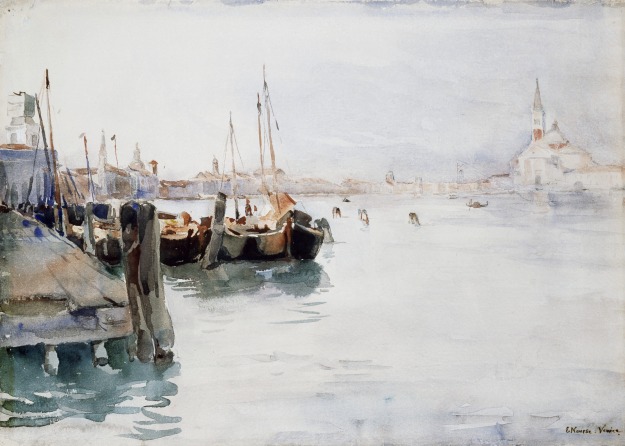Today's visit to the Telfair Museum's exhibition, Dutch Utopia: American Artists in Holland, 1880-1914, was a fascinating delight for a huge group of art lovers from Savannah and beyond. Curator Holly McCullough led everyone through the genesis, choices, history and social background of an exhibition she had worked on for long years.
Holland became a magnet for many American artists, men and women, who chose to work, sometimes in colonies, in many small towns throughout the country. They created paintings that reflected Holland's silvery light, seascapes and dunes. Other work depicted Dutch society, selectively and with an emphasis on older, traditional mores. People were portrayed as sober, hardworking, church-going, mostly garbed in costumes that were chosen more for their pictorial value than any accuracy of local costume. Gari Melchers, one of the main artists represented in the exhibition, with dramatic paintings large and small, had close ties to the Telfair as he was Fine Arts Advisor to the Museum early in the 20th century. His choice of art to be acquired, during his tenure at the Museum, led to holdings of these American artists working in Holland, such as Walter MacEwen and George Hitchcock. Other artists represented in the exhibition range from Robert Henri, William Merritt Chase, John Twachtman and John Singer Sargent to women like Elizabeth Nourse and Anna Stanley. They all spent time in one or more of the small towns and villages favoured by the artists for their timeless beauties.
Self Portrait, Elizabeth Nourse , 1892
Venice, watercolor over traces of pencil, 1891. Elizabeth Nourse, (Image courtesy of the Cincinnati Art Museum)
Girl carrying Sheaves (Harvest - Holland), c. 1895, Anna Henry, Private collection
The 17th century influences show in much of the art, from Franz Hals to Rembrandt or Vermeer, and the silvery light is a hallmark of many of the paintings. I delighted in some of the depictures of the leaded glass windows, always with spindly pot plants reaching for the light but managing to add touches of background colour to interior scenes. Other aspects of the paintings dwell on the essence of Holland - windmills, tulips, orderly streets and fishing boat scenes. It was thus not surprising that a number of these paintings had been in European public and private collections from the time they were produced, although many others had been purchased by the new collecting public in this country. The Telfair had assembled this show from public and private collections and many had not been exhibited in public for long years.
If you miss this exhibition in Savannah, you can catch it at the Taft Museum of Art in Cincinnati, Ohio, the Grand Rapids Art Museum, and finally at the Singer Laren Museum in the Netherlands. Thanks to Holly McCullough and her team, this exhibition is an unusual, fascinating and often very lovely exhibition well worth visiting.




